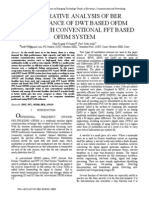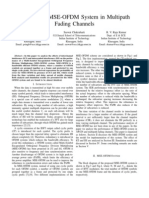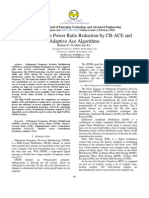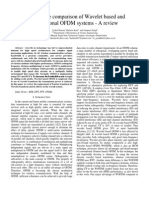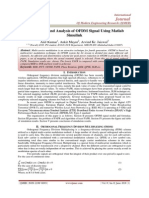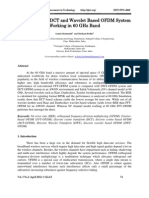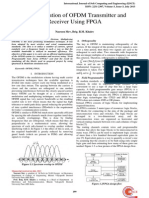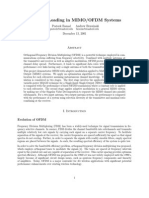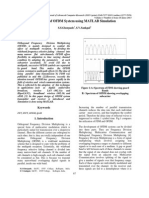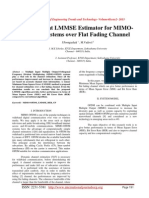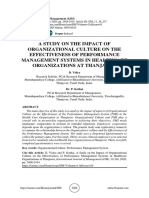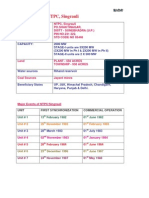Ijecet: International Journal of Electronics and Communication Engineering & Technology (Ijecet)
Ijecet: International Journal of Electronics and Communication Engineering & Technology (Ijecet)
Uploaded by
IAEME PublicationCopyright:
Available Formats
Ijecet: International Journal of Electronics and Communication Engineering & Technology (Ijecet)
Ijecet: International Journal of Electronics and Communication Engineering & Technology (Ijecet)
Uploaded by
IAEME PublicationOriginal Title
Copyright
Available Formats
Share this document
Did you find this document useful?
Is this content inappropriate?
Copyright:
Available Formats
Ijecet: International Journal of Electronics and Communication Engineering & Technology (Ijecet)
Ijecet: International Journal of Electronics and Communication Engineering & Technology (Ijecet)
Uploaded by
IAEME PublicationCopyright:
Available Formats
International Journal of Electronics and Communication Engineering & Technology (IJECET),
ISSN 0976 6464(Print), ISSN 0976 6472(Online), Volume 5, Issue 1, January (2014), IAEME
130
PAPR REDUCTION BY USING COMPLEMENTARY DUMMY SEQUENCE
INSERTION IN OFDM
Shirish L. Kotgire
1
, Shankar B. Deosarkar
2
1
(Electronics & Telecommunication Department, Dr. Babasaheb Ambedkar Technological
University Lonere, India)
2
(Electronics & Telecommunication Department, Dr. Babasaheb Ambedkar Technological
University Lonere, India)
ABSTRACT
In this paper a new low complexity distortion-less technique is proposed to reduce the Peak
to Average Power Ratio (PAPR) and to overcome problem of large envelope variation in OFDM
symbol by adding redundancy in the form of dummy sequence. This dummy sequence is determined
by performing number of iterations in such a way that the PAPR of the signal is reduced.
Combinations of dummy sequence along with partial transmit sequence results in reduced peaks and
lowers BER. As compared to conventional PTS technique the proposed technique requires lesser
IFFT operations. Complementary sequence is used as dummy and this sequence does not work as the
side information unlike the PTS and SLM methods. Two null symbols can also be added at regular
spacing in the OFDM symbol synchronization purpose. BER Performance of DSI is better than the
PTS and SLM since there is no degradation due to error in side information. If the PAPR of IFFT
output is lower than a certain prescribed PAPR threshold level, the IFFT output data is transmitted.
Otherwise, dummy sequence is inserted to lower the PAPR. This simplifies design of transmitter
amplifier and escalates the processing speed [1].
Keywords: Bit Error Rate (BER), Dummy Sequences, Orthogonal Frequency Division Multiplexing
(OFDM), Peak to Average Power Ratio (PAPR), Partial Transmit Sequence (PTS).
1. INTRODUCTION
Multi-carrier communication systems have several advantages over conventional single
carrier communication, such as high speed data transmission, better spectral efficiency, better noise
performance and insensitive to multi-path propagation. Due to this, multi-carrier communication is
being widely used in various wireless applications such as Digital Audio Broadcasting (DAB),
Digital Video Broadcasting (DVB), Various Wireless Local Area Networks (WLANs), personal and
INTERNATIONAL JOURNAL OF ELECTRONICS AND
COMMUNICATION ENGINEERING & TECHNOLOGY (IJECET)
ISSN 0976 6464(Print)
ISSN 0976 6472(Online)
Volume 5, Issue 1, January (2014), pp. 130-137
IAEME: www.iaeme.com/ijecet.asp
Journal Impact Factor (2013): 5.8896 (Calculated by GISI)
www.jifactor.com
IJECET
I A E M E
International Journal of Electronics and Communication Engineering & Technology (IJECET),
ISSN 0976 6464(Print), ISSN 0976 6472(Online), Volume 5, Issue 1, January (2014), IAEME
131
mobile communications. Moreover the available frequency spectrum can also be shared for digital
transmissions. However, a major drawback of multi-carrier signal is large peak to average power
ratio (PAPR) that results due to superimposition of large number of sub-carriers. Since the
transmitter power amplifiers are peak power limited, the large PAPR leads to in-band noise and out-
of-band radiation. Although the problem of large amplitude variation can be solved by increasing
the transmit power amplifier backoff, it comes with a side effect of reducing transmit power
amplifier efficiency. Achieving lower PAPR with acceptable Bit Error Rate (BER) is a challenging
task. Therefore, it is essential to propose multi-carrier techniques that result in low PAPR, lower
complexity, and lower noise while maintaining spectral efficiency [2].
1.1 Concept of OFDM
OFDM is a modulation technique used in multi-carrier communication. In this serial data is
converted into parallel and this parallel data symbol modulates a set of regularly spaced orthogonal
sub-carriers. The sub-carriers have minimum frequency separation required to maintain
orthogonality. The spectral overlap results in a waveform that uses the available bandwidth with a
very high spectral efficiency. Due to large symbol duration, OFDM is simple to use on channels that
exhibit delay spread or frequency selectivity. OFDM can be used to convert frequency selective
channel into a parallel collection of flat frequency sub-channels.
1.1.1 OFDM Concept
Basic arrangement used in OFDM transmitter is shown in Fig 1. OFDM modulator is
implemented as an N-point inverse discrete Fourier transform (IDFT) on a block of N information
symbols. Then these IDFT samples are followed by digital-to-analog converter (DAC). IDFT is
implemented using inverse fast Fourier transform (IFFT). A block of N complex symbols with an
appropriate signal constellation such as Quadrature phase shift keying (QPSK) or Quadrature
Amplitude Modulation (QAM) can be represented by {s
k
, k = 1,2, , N}. The IDFT of the data
block can be written as
1
0
2
exp , 0,1,..., 1,
N
n k
k
j nk
S s n N
N
=
= =
`
)
(1)
yielding the time domain sequence {S
n
, n = 1, , N}. Guard interval in the form of few samples (N
g
)
is also introduced in the form of cyclic prefix (CP) at the end of each block of OFDM symbol to
mitigate the effects of ISI. The length of cyclic prefix is kept larger than delay of a communication
channel.
Fig.1 Block diagram of basic OFDM transmitter.
International Journal of Electronics and Communication Engineering & Technology (IJECET),
ISSN 0976 6464(Print), ISSN 0976 6472(Online), Volume 5, Issue 1, January (2014), IAEME
132
At the receiver, the received complex baseband signal is sampled with an analog-to-digital
converter (ADC). After ADC, the guard interval of each OFDM symbol is removed. Then each
block of N received samples is converted back to the frequency domain using discrete Fourier
transform, as shown in Fig. 2.
Fig. 2 Block diagram of basic OFDM receiver
The FFT operation performs baseband demodulation. The N frequency domain samples are
processed with a simple one-tap Frequency Domain Equalizer (FDE) to recover the data symbols.
Superimposition of large number of statistically independent sub-carriers results in large
envelope variation and high peak values. Every transmission system is peak-power limited and is
having non-linear characteristics. Nonlinear characteristics cause spectral widening of the transmit
signal resulting in unwanted out-of-band (OOB) noise causing adjacent channel interference (ACI)
and the transmit signal itself is degraded due to nonlinearities, resulting in large bit error rate (BER).
In this research work an attempt has been made to propose techniques that will reduce large peaks.
Thus avoiding nonlinear distortion we can improve BER performance.
2. PAPR REDUCTION USING DUMMY COMPLEMENTARY SEQUENCE
A new distortion-less technique is proposed to reduce the PAPR and to overcome problem of
large envelope variation by adding redundancy in the form of dummy sequence in the OFDM
symbol. This dummy sequence is determined by performing number of iterations in such a way that
the PAPR of the signal is reduced. Combinations of dummy sequence along with partial transmit
sequence results in reduced peaks and lowers BER. As compared to conventional PTS technique the
proposed technique requires half the IFFT operations only. Complementary sequence is used as
dummy and this sequence does not work as the side information unlike the PTS and SLM methods.
BER Performance of DSI is better than the PTS and SLM since there is no degradation due to error
in side information [4]. If the PAPR of IFFT output is lower than a certain prescribed PAPR
threshold level, the IFFT output data is transmitted. Otherwise, dummy sequence is inserted to lower
the PAPR. Reduction in PAPR also makes transmitter amplifier design much simpler. This technique
escalates the processing speed. Additional null symbols can be added for synchronization purpose.
2.1 Generation of Complementary Sequence
In the proposed DSI technique Golay complementary sequences are used as dummy sequence
in the form of pair of binary codes, which consists of two codes of the same length n, whose auto-
correlation function have side-lobes equal in magnitude but opposite in sign. Summing these side
lobes result in a composite auto-correlation function with peak value of 2n and zero side-lobes [5].
Let a
i
and b
i
(i=1, 2, .,n) be the elements of two complementary series, such as
International Journal of Electronics and Communication Engineering & Technology (IJECET),
ISSN 0976 6464(Print), ISSN 0976
1 2 3
, , ,..., A a a a a =
The ordered pair (A:B) are Golay sequences of length n if and only if their associated polynomials
are:
A x a a x a x a x
and satisfy the identity
( ) ( A x A x B x B x n
The auto-correlation functions and
can be defined by the following expression
N j a a
N j bb
If we put the condition (5.2) in equation (
(
A B j
N j N j
The sum of both autocorrelation functions is 2N at j=0 and zero otherwise.
complex valued dummy sequences are generated first and then added to the vector of data sub
carriers. The addition of dummy sequences and data sub carrie
X1 D1 X2
Fig.3 Arrangement of Dummy Sequence and Data
In above figure X represents data subcarriers and D represents Dummy sequence
new vector S (new symbol) is given by
Where X
k
(X
1
, X
2
, X
3
, X4) is the number of groups i
(D
1
, D
2
, D
3
, D4) is the dummy sequence
sequence PAPR of the resulting signal is checked with that of
If the PAPR value is less than the threshold then the OFDM signal is transmitted otherwise the
dummy sequence is regenerated with the
Fig.2, X is the input signal with length N, after that dummy sequence is added. The dummy sequence
at the receiver can be replaced by zeros in the data samples. This makes the IFFT length without
change and decoding of the samples in receiver simpl
blocks becomes,
International Journal of Electronics and Communication Engineering & Technology (IJECET),
6464(Print), ISSN 0976 6472(Online), Volume 5, Issue 1, January (2014), IAEME
133
, , ,...,
n
A a a a a and
1 2 3
, , ,...,
n
B b b b b =
B) are Golay sequences of length n if and only if their associated polynomials
( )
2 1
1 2 3
, , ,...
n
n
A x a a x a x a x
=
( )
2 1
1 2 3
, , ,...
n
n
B x b b x b x b x
=
) ( ) ( )
1 1
2 A x A x B x B x n
+ =
and , corresponding to the sequences A and B respectively,
can be defined by the following expression
( )
( )
A i i j
i z
B i i j
j z
N j a a
N j bb
+
=
=
) in equation (5.3) we get
( ) ( )
2 , 0
0, 0
{
N j
A B j
N j N j
=
+ =
The sum of both autocorrelation functions is 2N at j=0 and zero otherwise. From
complex valued dummy sequences are generated first and then added to the vector of data sub
addition of dummy sequences and data sub carriers is shown in Fig. 3.
X2 D2 X3 D3 X4 D4
Arrangement of Dummy Sequence and Data Symbols
In above figure X represents data subcarriers and D represents Dummy sequence
is given by (7).
[ ]
,
k L
S X D =
, X4) is the number of groups into which the subcarriers are pa
is the dummy sequence added to reduce large peaks
.
After insertion of dummy
signal is checked with that of acceptable threshold that is pre
If the PAPR value is less than the threshold then the OFDM signal is transmitted otherwise the
generated with the help of number of iterations. From the block dia
, X is the input signal with length N, after that dummy sequence is added. The dummy sequence
at the receiver can be replaced by zeros in the data samples. This makes the IFFT length without
change and decoding of the samples in receiver simpler. Now the signal is partitioned
1, 2 3
, ,...,
m M
S S S S S ( =
International Journal of Electronics and Communication Engineering & Technology (IJECET),
6472(Online), Volume 5, Issue 1, January (2014), IAEME
(2)
B) are Golay sequences of length n if and only if their associated polynomials
(3)
(4)
corresponding to the sequences A and B respectively,
(5)
(6)
From equation (6)
complex valued dummy sequences are generated first and then added to the vector of data sub
[6]. Thus we get
(7)
nto which the subcarriers are partitioned and D
L
insertion of dummy
acceptable threshold that is pre-defined.
If the PAPR value is less than the threshold then the OFDM signal is transmitted otherwise the
From the block diagram in
, X is the input signal with length N, after that dummy sequence is added. The dummy sequence
at the receiver can be replaced by zeros in the data samples. This makes the IFFT length without
er. Now the signal is partitioned into M disjoint
(8)
International Journal of Electronics and Communication Engineering & Technology (IJECET),
ISSN 0976 6464(Print), ISSN 0976 6472(Online), Volume 5, Issue 1, January (2014), IAEME
134
Such that
1
M
m
m
S S
=
=
(9)
Then, these sub-blocks are combined to minimize the PAPR in time domain. However in time
domain the signal S
m
is oversampled L times which is obtained by taking an IFFT of length LN on X
m
concatenated with (L-1)N zeros. After partitioning the signal and performing the IFFT for each part,
the phase factors given by
, 1, 2, 3,...,
m
j
m
b e m M
= = (10)
are used for optimizing the S
m
in time domain. Then the OFDM signal becomes:
( )
1
'
M
m m
m
S b b S
=
=
(11)
This OFDM signal results in PAPR reduction. Simulation results show considerable decrease in
PAPR. This simplifies the design of high power transmitter amplifier.
3. PROPOSED CSI-PTS TECHNIQUE
The block schematic of complementary sequence insertion technique is shown in Fig. 3.
Complex complementary dummy sequence is first generated and then added to the OFDM symbol.
The new data symbol in the frequency domain is generated from k data and L-dummy subcarriers,
respectively. L can be any number less than the number of data symbols. The new vector S is given
by [7]:
S = [X
k
, W
]
where X
k
= [X
k,0
, X
k,1
, , X
k,N-L-1],
k = 1,2,,K is data sub-carrier vector and W
is thedummy
signal vector W
= [W
l,0,
W
l,1,
W
l,2,
W
l,L-1
], = 1, 2,,L is complementary dummy sequence. After
successive iterations dummy complementary sequence is added to the OFDM symbol. If PAPR value
is greater than the threshold then complementary sequence is generated again. After adding the
dummy sequence the signal is partitioned into M disjoint block
S
M
= [S1, S2, , SM] such that
1
M
m
m
S S
=
=
and then these sub-blocks combined to lower PAPR of
the transmit signal in time domain. After partitioning the signal and performing and performing IFFT
on each sub-block, the phase factors , 1, 2,...
m
j
m
b e m M
= = are used for optimizing each sub-block. In
time domain each sub-block can be represented as [8]:
s(b) =
1
M
m m
m
b s
=
Where s(b) =
( ) ( ) ( )
' ' '
0 1 1
, ,...,
T
NF
s b s b s b
(
. Minimum of s(b) can be determined by
iterations. The length of the input signal remains same after addition of complementary sequence.
International Journal of Electronics and Communication Engineering & Technology (IJECET),
ISSN 0976 6464(Print), ISSN 0976 6472(Online), Volume 5, Issue 1, January (2014), IAEME
135
Fig. 4. Block dig for complementary dummy sequence insertion
The process of determination of dummy signal continues, till the minimum or the value equal
to or less than threshold is reached and the signal is transmitted. As the dummy signal do not carry
any information, it is removed at the receiving end. The effect on bandwidth efficiency depends upon
the length of complementary sequence.
Computational Complexity
As no side information needs to be transmitted, and it can be reduced in terms of sub-block
partition as less number of IFFT computations is required. And this is due to the addition of dummy
sequence. In many wireless applications number of zeros is added before transmission. Some of
these zeros can be replaced by this complementary sequence which reduces PAPR and hence design
of transmitter amplifier gets simplified and fewer distortions will occur in the signal at less
complexity.
However, addition of complementary sequence affects bandwidth efficiency.
Spectral Efficiency Loss =
100%
Number of data subcarriers
Number of data scbcarriers Number of dummy sequences
=
+
4. RESULTS AND CONCLUSIONS
Matlab simulation of dummy complementary sequence for 256 sub-carrier system using
different lengths of complementary sequences was performed using different modulation techniques.
We employed QPSK modulation with oversampling factor D = 4. Ten thousand random OFDM
symbols were simulated for determining CCDF. Simulation results in Fig.5. shows considerable
improvement in PAPR for dummy sequence of length 4 and 8 with subcarriers divided into four
partitions of 64 subcarriers each. It can be observed that as compared to conventional PTS proposed
scheme shows an improvement of the order of 5-6 dB at CCDF of 10
-2
. PAPR reduction is achieved
without any transmission of side information with low computational complexity.
International Journal of Electronics and Communication Engineering & Technology (IJECET),
ISSN 0976 6464(Print), ISSN 0976 6472(Online), Volume 5, Issue 1, January (2014), IAEME
136
Fig.5. PAPR Reduction for various length of complementary sequences
Fig. 6. And Fog. 7 shows an improvement in BER. It is observed that for SNR of 12dB there is
considerable improvement in BER for the dummy sequence length of 4 and 8. These results show
considerable reduction in PAPR without significant spectral efficiency loss. Since dummy
Fig. 6 BER vs SNR plot for dummy sequence length DS = 4
Fig. 7 BER vs SNR plot for dummy sequence length DS = 8
International Journal of Electronics and Communication Engineering & Technology (IJECET),
ISSN 0976 6464(Print), ISSN 0976 6472(Online), Volume 5, Issue 1, January (2014), IAEME
137
REFERENCES
[1] H. G. Ryu, J. E. Lee and J.S. Park, Dummy sequence insertion (DSI) for PAPR reduction in
the OFDM communication, system IEEE Trans. Consumer Electr., vol.50, no. 1, pp. 89-94,
Feb. 2004.
[2] S. H. Han and J. H. Lee, An overview of peak-to-average power ratio reduction techniques
for multicarrier transmission, IEEE Wireless Commun.,vol.12, no. 2, pp. 56-65, Apr.. 2005.
[3] Ye(Geoffrey) Li and Gordon L. Stubber, Orthogonal Frequency Division Multiplexing for
Wireless Communications, (Springer 2006).
[4] L. Yang, R. S. Chen, Y. M. Siu, and K. K. Soo,PAPR reduction of an OFDM signal by use
of PTS with low computational complexity, IEEE Trans. Broadcast., vol. 52, no. 1,pp. 83-
86, March 2006.
[5] T. Jiang, and Y. Wu, An overview: peak-to-average power ratio reduction techniques for
OFDM signals, IEEE Trans. Broadcast., vol. 54no. 2, pp. 257-268, June 2008
[6] P. Varahram, Wisam F. Al-Azoo, Borhanuddin Mohd Ali, A Low Complexity PTS scheme
by Use of Dummy Signals for PAPR Reduction in OFDM Systems, IEEE Transactions on
Consumer Electronics, vol 56, No. 4, Nov. pp. 2416-2420 Nov.2010.
[7] R.E. Moore, Interval analysis (Englewood Cliffs, NJ: Prentice-Hall, 1966).
[8] P. Uthansakul, S. Chaokuntod, and M. Uthansakul, Fast Dummy Sequence Insertion Method
for PAPR reductionin WiMax Systems, International Journal of Electronics,
Communication and Computer Engineering, vol. 1, no. 3, 2009
[9] L. Yang, K. K. Soo, S. Q. Li, and Y. M. Siu, PAPR Reduction Using Low Complexity PTS
to Construct OFDM Signals Without Side Information, IEEE Trans. On Broadcasting, vol.
57, no. 2, pp. 284-290, June 2011.
[10] Bharti Rani, Mrs Garima Saini, Cooperative Partial Transmit Sequence for PAPR Reduction
in Space Frequency Block Code MIMO-OFDM Signal, International Journal of Electronics
and Communication Engineering & Technology (IJECET), Volume 3, Issue 2, 2012, pp. 321
- 327, ISSN Print: 0976- 6464, ISSN Online: 0976 6472.
[11] K.Muralibabu, Dr.K.Ramanaidu, Dr.S.Padmanabhan and Dr.T.K.Shanthi, A Novel PAPR
Reduction Scheme using Discrete Cosine Transform Based on Subcarrier Grouping in
OFDM System, International Journal of Electronics and Communication Engineering &
Technology (IJECET), Volume 3, Issue 3, 2012, pp. 251 - 257, ISSN Print: 0976- 6464,
ISSN Online: 0976 6472.
[12] Ashok Kumar Kajla, Rupesh Sharma, Yash Walia and Sukoon Mishra, Improve Peak To
Average Power Ratio (PAPR) Reduction Techniques in OFDM System, International
Journal of Electronics and Communication Engineering & Technology (IJECET), Volume 4,
Issue 7, 2013, pp. 28 - 35, ISSN Print: 0976- 6464, ISSN Online: 0976 6472.
[13] Shraddha R. Waghmare and Prof. Dr. Shripad P. Mohani, A New Approach in
Distortionless Techniques for PAPR Reduction in Multicarrier Transmission Systems,
International Journal of Electronics and Communication Engineering & Technology
(IJECET), Volume 4, Issue 5, 2013, pp. 207 - 213, ISSN Print: 0976- 6464, ISSN Online:
0976 6472.
You might also like
- Supply Chain of Automotive Industry V/S Suplly Chain of FMCG IndustryNo ratings yetSupply Chain of Automotive Industry V/S Suplly Chain of FMCG Industry9 pages
- Introduction To Oracle Enterprise Asset ManagementNo ratings yetIntroduction To Oracle Enterprise Asset Management59 pages
- IEC-OP-02 OP For Internal & External CommunicationNo ratings yetIEC-OP-02 OP For Internal & External Communication4 pages
- Comparison of PAPR Reduction OFDM Systems Techniques In: Preenu Ann P Renu JoseNo ratings yetComparison of PAPR Reduction OFDM Systems Techniques In: Preenu Ann P Renu Jose5 pages
- A Humble Method Based On Trimming and Differential Topping To Reduce The PAPR in OFDM SystemsNo ratings yetA Humble Method Based On Trimming and Differential Topping To Reduce The PAPR in OFDM Systems6 pages
- BER of OFDM System Using Concatenated Forward Error Correcting Codes (FEC) Over Nakagami-M Fading Channel100% (1)BER of OFDM System Using Concatenated Forward Error Correcting Codes (FEC) Over Nakagami-M Fading Channel5 pages
- Improvement of PAPR and BER in OFDM Using Combination of SLM and Clipping TechniquesNo ratings yetImprovement of PAPR and BER in OFDM Using Combination of SLM and Clipping Techniques6 pages
- GOYANI - A Review - Performance Comparison of Conventional and Wavelet Based OFDM SystemNo ratings yetGOYANI - A Review - Performance Comparison of Conventional and Wavelet Based OFDM System4 pages
- Comparative Analysis of Ber Performance of DWT Based Ofdm System With Conventional FFT Based Ofdm SystemNo ratings yetComparative Analysis of Ber Performance of DWT Based Ofdm System With Conventional FFT Based Ofdm System6 pages
- Performance of Linear Block Coded OFDM System in BER and PAPR Under Different ChannelsNo ratings yetPerformance of Linear Block Coded OFDM System in BER and PAPR Under Different Channels7 pages
- An Experimental Study To Reduce The Effect of ICI in OFDM Based WLAN SystemNo ratings yetAn Experimental Study To Reduce The Effect of ICI in OFDM Based WLAN System4 pages
- Performance Enhancement of MIMO-OFDM System Using PTS To Achieve Optimum BER & PaprNo ratings yetPerformance Enhancement of MIMO-OFDM System Using PTS To Achieve Optimum BER & Papr9 pages
- Adaptive Offset Dividing and Squaring Technique For PAPR Reduction in OFDM SystemNo ratings yetAdaptive Offset Dividing and Squaring Technique For PAPR Reduction in OFDM System5 pages
- Analysis of MSE-OFDM System in Multipath Fading Channels: Poonam Singh Saswat Chakrabarti R. V. Raja KumarNo ratings yetAnalysis of MSE-OFDM System in Multipath Fading Channels: Poonam Singh Saswat Chakrabarti R. V. Raja Kumar5 pages
- Discrete Cosinetransform-Ii For Reduction in Peak To Average Power Ratio of Ofdm Signals Through - Law Companding TechniqueNo ratings yetDiscrete Cosinetransform-Ii For Reduction in Peak To Average Power Ratio of Ofdm Signals Through - Law Companding Technique14 pages
- Peak-to-Average Power Reduction in OFCDM System To Enhance The Spectral EfficiencyNo ratings yetPeak-to-Average Power Reduction in OFCDM System To Enhance The Spectral Efficiency6 pages
- Peak-To-Average Power Ratio Reduction by CB-ACE and Adaptive Ace AlgorithmsNo ratings yetPeak-To-Average Power Ratio Reduction by CB-ACE and Adaptive Ace Algorithms8 pages
- PAPR Reduction Techniques in OFDM SystemNo ratings yetPAPR Reduction Techniques in OFDM System7 pages
- Effect of Carrier Frequency Offset On SER of OFDM SystemNo ratings yetEffect of Carrier Frequency Offset On SER of OFDM System5 pages
- Error Probability of Different Modulation Schemes For OFDM Based WLAN Standard IEEE 802.11aNo ratings yetError Probability of Different Modulation Schemes For OFDM Based WLAN Standard IEEE 802.11a6 pages
- Comparative Evaluation of Bit Error Rate For Different Ofdm Subcarriers in Rayleigh ChannelNo ratings yetComparative Evaluation of Bit Error Rate For Different Ofdm Subcarriers in Rayleigh Channel8 pages
- Performance Comparison of Wavelet Based and Conventional OFDM Systems - A ReviewNo ratings yetPerformance Comparison of Wavelet Based and Conventional OFDM Systems - A Review4 pages
- Analysis The Utility & Comparative Study of Reduction Techniques of Peak-to-Average Power Ratio (PAPR) in OFDM System & Its Performance AnalysisNo ratings yetAnalysis The Utility & Comparative Study of Reduction Techniques of Peak-to-Average Power Ratio (PAPR) in OFDM System & Its Performance Analysis8 pages
- Comparative Performance Analysis of Different Modulation Techniques For Papr Reduction of Ofdm SignalNo ratings yetComparative Performance Analysis of Different Modulation Techniques For Papr Reduction of Ofdm Signal11 pages
- Performance and Analysis of OFDM Signal Using Matlab SimulinkNo ratings yetPerformance and Analysis of OFDM Signal Using Matlab Simulink7 pages
- Performance Analysis of OFDM For Different Modulation TechniquesNo ratings yetPerformance Analysis of OFDM For Different Modulation Techniques6 pages
- Bit Error Rate Evaluation of IEEE 802.16 in OFDM SystemNo ratings yetBit Error Rate Evaluation of IEEE 802.16 in OFDM System4 pages
- Modified Pts With Fecs For Papr Reduction in Mimo-Ofdm System With Different SubcarriersNo ratings yetModified Pts With Fecs For Papr Reduction in Mimo-Ofdm System With Different Subcarriers6 pages
- BER and PAPR Reduction Using Companding Algorithms in OFDMNo ratings yetBER and PAPR Reduction Using Companding Algorithms in OFDM5 pages
- PAPR Reduction of OFDM Signals Using Active Constellation Extension and Tone Reservation Hybrid SchemeNo ratings yetPAPR Reduction of OFDM Signals Using Active Constellation Extension and Tone Reservation Hybrid Scheme8 pages
- Peak-to-Average Power Ratio in WFMT Systems: Roman M. VitenbergNo ratings yetPeak-to-Average Power Ratio in WFMT Systems: Roman M. Vitenberg4 pages
- An Overview of Peak-To-Average Power Ratio Reduction Techniques For Ofdm SignalsNo ratings yetAn Overview of Peak-To-Average Power Ratio Reduction Techniques For Ofdm Signals20 pages
- Low Complexity Partial SLM Technique For PAPR Reduction in OFDM TransmittersNo ratings yetLow Complexity Partial SLM Technique For PAPR Reduction in OFDM Transmitters11 pages
- Development of A Matlab Simulation Environment For VehicleNo ratings yetDevelopment of A Matlab Simulation Environment For Vehicle7 pages
- Comparison of DCT and Wavelet Based Ofdm System Working in 60 GHZ BandNo ratings yetComparison of DCT and Wavelet Based Ofdm System Working in 60 GHZ Band10 pages
- Performance Analysis of DCO-OfDM in VLC SystemNo ratings yetPerformance Analysis of DCO-OfDM in VLC System6 pages
- Implementation of OFDM Transmitter and Receiver Using FPGA: Nasreen Mev, Brig. R.M. KhaireNo ratings yetImplementation of OFDM Transmitter and Receiver Using FPGA: Nasreen Mev, Brig. R.M. Khaire4 pages
- Papr Reduction of Ofdm Signal Using Turbo Coding and Selective MappingNo ratings yetPapr Reduction of Ofdm Signal Using Turbo Coding and Selective Mapping4 pages
- An Efficient Technique For Reducing Papr of Ofdm System in The Presence of Nonlinear High Power Amplifier H. Y. Sakran, M. Shokair, and A. A. ElazmNo ratings yetAn Efficient Technique For Reducing Papr of Ofdm System in The Presence of Nonlinear High Power Amplifier H. Y. Sakran, M. Shokair, and A. A. Elazm9 pages
- Using Raised Cosine Filter To Reduce Inter Symbol Interference in OFDM With BPSK TechniqueNo ratings yetUsing Raised Cosine Filter To Reduce Inter Symbol Interference in OFDM With BPSK Technique5 pages
- Modified Pts With Fecs For Papr Reduction in Mimo-Ofdm System With Different SubcarriersNo ratings yetModified Pts With Fecs For Papr Reduction in Mimo-Ofdm System With Different Subcarriers11 pages
- A Weighted OFDM Signal Scheme For Peak-to-Average Power Ratio Reduction of OFDM SignalsNo ratings yetA Weighted OFDM Signal Scheme For Peak-to-Average Power Ratio Reduction of OFDM Signals4 pages
- Behaviour of OFDM System Using MATLAB SimulationNo ratings yetBehaviour of OFDM System Using MATLAB Simulation5 pages
- Nonlinear Commanding Transform Algorithm For Peak - To-Average Power Ratio Reduction Technique of OFDM SignalNo ratings yetNonlinear Commanding Transform Algorithm For Peak - To-Average Power Ratio Reduction Technique of OFDM Signal6 pages
- An Efficient LMMSE Estimator For MIMOOFDM Systems Over Flat Fading ChannelNo ratings yetAn Efficient LMMSE Estimator For MIMOOFDM Systems Over Flat Fading Channel4 pages
- A Comparative Performance Analysis of OFDM Using MATLAB Simulation With M-PSK and M-QAM MappingNo ratings yetA Comparative Performance Analysis of OFDM Using MATLAB Simulation With M-PSK and M-QAM Mapping5 pages
- A Comparative Approach Between Clipping and Probabilistic Technique For Reducing PAPR of OFDM SystemNo ratings yetA Comparative Approach Between Clipping and Probabilistic Technique For Reducing PAPR of OFDM System10 pages
- Peak-To-Average Power Ratio Reduction of Ofdm SiganlsNo ratings yetPeak-To-Average Power Ratio Reduction of Ofdm Siganls5 pages
- RF Analog Impairments Modeling for Communication Systems Simulation: Application to OFDM-based TransceiversFrom EverandRF Analog Impairments Modeling for Communication Systems Simulation: Application to OFDM-based TransceiversNo ratings yet
- Enabling Technologies for High Spectral-efficiency Coherent Optical Communication NetworksFrom EverandEnabling Technologies for High Spectral-efficiency Coherent Optical Communication NetworksNo ratings yet
- Broad Unexposed Skills of Transgender EntrepreneursNo ratings yetBroad Unexposed Skills of Transgender Entrepreneurs8 pages
- Influence of Talent Management Practices On Organizational Performance A Study With Reference To It Sector in ChennaiNo ratings yetInfluence of Talent Management Practices On Organizational Performance A Study With Reference To It Sector in Chennai16 pages
- Voice Based Atm For Visually Impaired Using ArduinoNo ratings yetVoice Based Atm For Visually Impaired Using Arduino7 pages
- A Study On The Impact of Organizational Culture On The Effectiveness of Performance Management Systems in Healthcare Organizations at ThanjavurNo ratings yetA Study On The Impact of Organizational Culture On The Effectiveness of Performance Management Systems in Healthcare Organizations at Thanjavur7 pages
- A Study of Various Types of Loans of Selected Public and Private Sector Banks With Reference To Npa in State HaryanaNo ratings yetA Study of Various Types of Loans of Selected Public and Private Sector Banks With Reference To Npa in State Haryana9 pages
- A Study On Talent Management and Its Impact On Employee Retention in Selected It Organizations in ChennaiNo ratings yetA Study On Talent Management and Its Impact On Employee Retention in Selected It Organizations in Chennai16 pages
- Role of Social Entrepreneurship in Rural Development of India - Problems and ChallengesNo ratings yetRole of Social Entrepreneurship in Rural Development of India - Problems and Challenges18 pages
- Financial Literacy On Investment Performance: The Mediating Effect of Big-Five Personality Traits ModelNo ratings yetFinancial Literacy On Investment Performance: The Mediating Effect of Big-Five Personality Traits Model9 pages
- Optimal Reconfiguration of Power Distribution Radial Network Using Hybrid Meta-Heuristic AlgorithmsNo ratings yetOptimal Reconfiguration of Power Distribution Radial Network Using Hybrid Meta-Heuristic Algorithms13 pages
- Various Fuzzy Numbers and Their Various Ranking ApproachesNo ratings yetVarious Fuzzy Numbers and Their Various Ranking Approaches10 pages
- Application of Frugal Approach For Productivity Improvement - A Case Study of Mahindra and Mahindra LTDNo ratings yetApplication of Frugal Approach For Productivity Improvement - A Case Study of Mahindra and Mahindra LTD19 pages
- Quality of Work-Life On Employee Retention and Job Satisfaction: The Moderating Role of Job PerformanceNo ratings yetQuality of Work-Life On Employee Retention and Job Satisfaction: The Moderating Role of Job Performance7 pages
- A Proficient Minimum-Routine Reliable Recovery Line Accumulation Scheme For Non-Deterministic Mobile Distributed FrameworksNo ratings yetA Proficient Minimum-Routine Reliable Recovery Line Accumulation Scheme For Non-Deterministic Mobile Distributed Frameworks10 pages
- A Review of Particle Swarm Optimization (Pso) AlgorithmNo ratings yetA Review of Particle Swarm Optimization (Pso) Algorithm26 pages
- Analyzability Metric For Maintainability of Object Oriented Software SystemNo ratings yetAnalyzability Metric For Maintainability of Object Oriented Software System14 pages
- 1. What does it mean to inherit a class? Mark for Review (1) Points The subclass (or child class) gains access to any non-private methods and variables of the superclass (or parent class). (*) The access specifier has been set to private. A way of organizing the hierarchy of classes. Extending a method from a superclass. Correct 2. Which is the most accurate description of the code reuse philosophy? Mark for Review (1) Points A programming philosophy that promotes stealing your classmates' code. A programming philosophy that promotes having no concern about the security of code. A programming philosophy that promotes protecting data and hiding implementation in order to preserve the integrity of data and methods. A programming philosophy that promotes simpler, more efficient coding by using existing code for new applicationsNo ratings yet1. What does it mean to inherit a class? Mark for Review (1) Points The subclass (or child class) gains access to any non-private methods and variables of the superclass (or parent class). (*) The access specifier has been set to private. A way of organizing the hierarchy of classes. Extending a method from a superclass. Correct 2. Which is the most accurate description of the code reuse philosophy? Mark for Review (1) Points A programming philosophy that promotes stealing your classmates' code. A programming philosophy that promotes having no concern about the security of code. A programming philosophy that promotes protecting data and hiding implementation in order to preserve the integrity of data and methods. A programming philosophy that promotes simpler, more efficient coding by using existing code for new applications4 pages
- The Four (4) Primary Models of Software Development Methods: Eka Arriyanti100% (2)The Four (4) Primary Models of Software Development Methods: Eka Arriyanti14 pages
- Analysis in Time Series Model For RGUKT, R.K. Valley Campus HT Feeder Load Forecasting Using Linear RegressionNo ratings yetAnalysis in Time Series Model For RGUKT, R.K. Valley Campus HT Feeder Load Forecasting Using Linear Regression2 pages
- Design Report Moulding Bracket 24-02-16No ratings yetDesign Report Moulding Bracket 24-02-1623 pages
- Cip Safety Pf527 Hott 2015 v1 - 2 Mar 18 2015100% (1)Cip Safety Pf527 Hott 2015 v1 - 2 Mar 18 201516 pages
- t2l-t2lf - Authentication by Electronic Means - Notifications - Rev8No ratings yett2l-t2lf - Authentication by Electronic Means - Notifications - Rev813 pages
- Terminal 2: Level 4 - Retail Mezzanine - Part Plan - 55No ratings yetTerminal 2: Level 4 - Retail Mezzanine - Part Plan - 551 page
- Atmel 2564 Using The TWI Module As I2C Master ApplicationNote AVR315No ratings yetAtmel 2564 Using The TWI Module As I2C Master ApplicationNote AVR31514 pages
- ASTM D 2217 - 85 (Reapproved 1993) 2217 - 85 (Reapproved 1998) Standard Practice For Wet Preparation of Soil Samples For Particle Size Analysis and Determination of Soil ConstantNo ratings yetASTM D 2217 - 85 (Reapproved 1993) 2217 - 85 (Reapproved 1998) Standard Practice For Wet Preparation of Soil Samples For Particle Size Analysis and Determination of Soil Constant2 pages
- Evolution of Services in 3G Network: Lecture Notes Dea Misi 1 March 04No ratings yetEvolution of Services in 3G Network: Lecture Notes Dea Misi 1 March 0481 pages
- Pay-Unpaid/Re-Print Exam Form Receipt: Your Application Payment Has Been DoneNo ratings yetPay-Unpaid/Re-Print Exam Form Receipt: Your Application Payment Has Been Done2 pages
- Supply Chain of Automotive Industry V/S Suplly Chain of FMCG IndustrySupply Chain of Automotive Industry V/S Suplly Chain of FMCG Industry
- Introduction To Oracle Enterprise Asset ManagementIntroduction To Oracle Enterprise Asset Management
- IEC-OP-02 OP For Internal & External CommunicationIEC-OP-02 OP For Internal & External Communication
- Comparison of PAPR Reduction OFDM Systems Techniques In: Preenu Ann P Renu JoseComparison of PAPR Reduction OFDM Systems Techniques In: Preenu Ann P Renu Jose
- A Humble Method Based On Trimming and Differential Topping To Reduce The PAPR in OFDM SystemsA Humble Method Based On Trimming and Differential Topping To Reduce The PAPR in OFDM Systems
- BER of OFDM System Using Concatenated Forward Error Correcting Codes (FEC) Over Nakagami-M Fading ChannelBER of OFDM System Using Concatenated Forward Error Correcting Codes (FEC) Over Nakagami-M Fading Channel
- Improvement of PAPR and BER in OFDM Using Combination of SLM and Clipping TechniquesImprovement of PAPR and BER in OFDM Using Combination of SLM and Clipping Techniques
- GOYANI - A Review - Performance Comparison of Conventional and Wavelet Based OFDM SystemGOYANI - A Review - Performance Comparison of Conventional and Wavelet Based OFDM System
- Comparative Analysis of Ber Performance of DWT Based Ofdm System With Conventional FFT Based Ofdm SystemComparative Analysis of Ber Performance of DWT Based Ofdm System With Conventional FFT Based Ofdm System
- Performance of Linear Block Coded OFDM System in BER and PAPR Under Different ChannelsPerformance of Linear Block Coded OFDM System in BER and PAPR Under Different Channels
- An Experimental Study To Reduce The Effect of ICI in OFDM Based WLAN SystemAn Experimental Study To Reduce The Effect of ICI in OFDM Based WLAN System
- Performance Enhancement of MIMO-OFDM System Using PTS To Achieve Optimum BER & PaprPerformance Enhancement of MIMO-OFDM System Using PTS To Achieve Optimum BER & Papr
- Adaptive Offset Dividing and Squaring Technique For PAPR Reduction in OFDM SystemAdaptive Offset Dividing and Squaring Technique For PAPR Reduction in OFDM System
- Analysis of MSE-OFDM System in Multipath Fading Channels: Poonam Singh Saswat Chakrabarti R. V. Raja KumarAnalysis of MSE-OFDM System in Multipath Fading Channels: Poonam Singh Saswat Chakrabarti R. V. Raja Kumar
- Discrete Cosinetransform-Ii For Reduction in Peak To Average Power Ratio of Ofdm Signals Through - Law Companding TechniqueDiscrete Cosinetransform-Ii For Reduction in Peak To Average Power Ratio of Ofdm Signals Through - Law Companding Technique
- Peak-to-Average Power Reduction in OFCDM System To Enhance The Spectral EfficiencyPeak-to-Average Power Reduction in OFCDM System To Enhance The Spectral Efficiency
- Peak-To-Average Power Ratio Reduction by CB-ACE and Adaptive Ace AlgorithmsPeak-To-Average Power Ratio Reduction by CB-ACE and Adaptive Ace Algorithms
- Effect of Carrier Frequency Offset On SER of OFDM SystemEffect of Carrier Frequency Offset On SER of OFDM System
- Error Probability of Different Modulation Schemes For OFDM Based WLAN Standard IEEE 802.11aError Probability of Different Modulation Schemes For OFDM Based WLAN Standard IEEE 802.11a
- Comparative Evaluation of Bit Error Rate For Different Ofdm Subcarriers in Rayleigh ChannelComparative Evaluation of Bit Error Rate For Different Ofdm Subcarriers in Rayleigh Channel
- Performance Comparison of Wavelet Based and Conventional OFDM Systems - A ReviewPerformance Comparison of Wavelet Based and Conventional OFDM Systems - A Review
- Analysis The Utility & Comparative Study of Reduction Techniques of Peak-to-Average Power Ratio (PAPR) in OFDM System & Its Performance AnalysisAnalysis The Utility & Comparative Study of Reduction Techniques of Peak-to-Average Power Ratio (PAPR) in OFDM System & Its Performance Analysis
- Comparative Performance Analysis of Different Modulation Techniques For Papr Reduction of Ofdm SignalComparative Performance Analysis of Different Modulation Techniques For Papr Reduction of Ofdm Signal
- Performance and Analysis of OFDM Signal Using Matlab SimulinkPerformance and Analysis of OFDM Signal Using Matlab Simulink
- Performance Analysis of OFDM For Different Modulation TechniquesPerformance Analysis of OFDM For Different Modulation Techniques
- Bit Error Rate Evaluation of IEEE 802.16 in OFDM SystemBit Error Rate Evaluation of IEEE 802.16 in OFDM System
- Modified Pts With Fecs For Papr Reduction in Mimo-Ofdm System With Different SubcarriersModified Pts With Fecs For Papr Reduction in Mimo-Ofdm System With Different Subcarriers
- BER and PAPR Reduction Using Companding Algorithms in OFDMBER and PAPR Reduction Using Companding Algorithms in OFDM
- PAPR Reduction of OFDM Signals Using Active Constellation Extension and Tone Reservation Hybrid SchemePAPR Reduction of OFDM Signals Using Active Constellation Extension and Tone Reservation Hybrid Scheme
- Peak-to-Average Power Ratio in WFMT Systems: Roman M. VitenbergPeak-to-Average Power Ratio in WFMT Systems: Roman M. Vitenberg
- An Overview of Peak-To-Average Power Ratio Reduction Techniques For Ofdm SignalsAn Overview of Peak-To-Average Power Ratio Reduction Techniques For Ofdm Signals
- Low Complexity Partial SLM Technique For PAPR Reduction in OFDM TransmittersLow Complexity Partial SLM Technique For PAPR Reduction in OFDM Transmitters
- Development of A Matlab Simulation Environment For VehicleDevelopment of A Matlab Simulation Environment For Vehicle
- Comparison of DCT and Wavelet Based Ofdm System Working in 60 GHZ BandComparison of DCT and Wavelet Based Ofdm System Working in 60 GHZ Band
- Implementation of OFDM Transmitter and Receiver Using FPGA: Nasreen Mev, Brig. R.M. KhaireImplementation of OFDM Transmitter and Receiver Using FPGA: Nasreen Mev, Brig. R.M. Khaire
- Papr Reduction of Ofdm Signal Using Turbo Coding and Selective MappingPapr Reduction of Ofdm Signal Using Turbo Coding and Selective Mapping
- An Efficient Technique For Reducing Papr of Ofdm System in The Presence of Nonlinear High Power Amplifier H. Y. Sakran, M. Shokair, and A. A. ElazmAn Efficient Technique For Reducing Papr of Ofdm System in The Presence of Nonlinear High Power Amplifier H. Y. Sakran, M. Shokair, and A. A. Elazm
- Using Raised Cosine Filter To Reduce Inter Symbol Interference in OFDM With BPSK TechniqueUsing Raised Cosine Filter To Reduce Inter Symbol Interference in OFDM With BPSK Technique
- Modified Pts With Fecs For Papr Reduction in Mimo-Ofdm System With Different SubcarriersModified Pts With Fecs For Papr Reduction in Mimo-Ofdm System With Different Subcarriers
- A Weighted OFDM Signal Scheme For Peak-to-Average Power Ratio Reduction of OFDM SignalsA Weighted OFDM Signal Scheme For Peak-to-Average Power Ratio Reduction of OFDM Signals
- Nonlinear Commanding Transform Algorithm For Peak - To-Average Power Ratio Reduction Technique of OFDM SignalNonlinear Commanding Transform Algorithm For Peak - To-Average Power Ratio Reduction Technique of OFDM Signal
- An Efficient LMMSE Estimator For MIMOOFDM Systems Over Flat Fading ChannelAn Efficient LMMSE Estimator For MIMOOFDM Systems Over Flat Fading Channel
- A Comparative Performance Analysis of OFDM Using MATLAB Simulation With M-PSK and M-QAM MappingA Comparative Performance Analysis of OFDM Using MATLAB Simulation With M-PSK and M-QAM Mapping
- A Comparative Approach Between Clipping and Probabilistic Technique For Reducing PAPR of OFDM SystemA Comparative Approach Between Clipping and Probabilistic Technique For Reducing PAPR of OFDM System
- Peak-To-Average Power Ratio Reduction of Ofdm SiganlsPeak-To-Average Power Ratio Reduction of Ofdm Siganls
- RF Analog Impairments Modeling for Communication Systems Simulation: Application to OFDM-based TransceiversFrom EverandRF Analog Impairments Modeling for Communication Systems Simulation: Application to OFDM-based Transceivers
- Enabling Technologies for High Spectral-efficiency Coherent Optical Communication NetworksFrom EverandEnabling Technologies for High Spectral-efficiency Coherent Optical Communication Networks
- Broad Unexposed Skills of Transgender EntrepreneursBroad Unexposed Skills of Transgender Entrepreneurs
- Influence of Talent Management Practices On Organizational Performance A Study With Reference To It Sector in ChennaiInfluence of Talent Management Practices On Organizational Performance A Study With Reference To It Sector in Chennai
- Voice Based Atm For Visually Impaired Using ArduinoVoice Based Atm For Visually Impaired Using Arduino
- A Study On The Impact of Organizational Culture On The Effectiveness of Performance Management Systems in Healthcare Organizations at ThanjavurA Study On The Impact of Organizational Culture On The Effectiveness of Performance Management Systems in Healthcare Organizations at Thanjavur
- A Study of Various Types of Loans of Selected Public and Private Sector Banks With Reference To Npa in State HaryanaA Study of Various Types of Loans of Selected Public and Private Sector Banks With Reference To Npa in State Haryana
- A Study On Talent Management and Its Impact On Employee Retention in Selected It Organizations in ChennaiA Study On Talent Management and Its Impact On Employee Retention in Selected It Organizations in Chennai
- Role of Social Entrepreneurship in Rural Development of India - Problems and ChallengesRole of Social Entrepreneurship in Rural Development of India - Problems and Challenges
- Financial Literacy On Investment Performance: The Mediating Effect of Big-Five Personality Traits ModelFinancial Literacy On Investment Performance: The Mediating Effect of Big-Five Personality Traits Model
- Optimal Reconfiguration of Power Distribution Radial Network Using Hybrid Meta-Heuristic AlgorithmsOptimal Reconfiguration of Power Distribution Radial Network Using Hybrid Meta-Heuristic Algorithms
- Various Fuzzy Numbers and Their Various Ranking ApproachesVarious Fuzzy Numbers and Their Various Ranking Approaches
- Application of Frugal Approach For Productivity Improvement - A Case Study of Mahindra and Mahindra LTDApplication of Frugal Approach For Productivity Improvement - A Case Study of Mahindra and Mahindra LTD
- Quality of Work-Life On Employee Retention and Job Satisfaction: The Moderating Role of Job PerformanceQuality of Work-Life On Employee Retention and Job Satisfaction: The Moderating Role of Job Performance
- A Proficient Minimum-Routine Reliable Recovery Line Accumulation Scheme For Non-Deterministic Mobile Distributed FrameworksA Proficient Minimum-Routine Reliable Recovery Line Accumulation Scheme For Non-Deterministic Mobile Distributed Frameworks
- A Review of Particle Swarm Optimization (Pso) AlgorithmA Review of Particle Swarm Optimization (Pso) Algorithm
- Analyzability Metric For Maintainability of Object Oriented Software SystemAnalyzability Metric For Maintainability of Object Oriented Software System
- 1. What does it mean to inherit a class? Mark for Review (1) Points The subclass (or child class) gains access to any non-private methods and variables of the superclass (or parent class). (*) The access specifier has been set to private. A way of organizing the hierarchy of classes. Extending a method from a superclass. Correct 2. Which is the most accurate description of the code reuse philosophy? Mark for Review (1) Points A programming philosophy that promotes stealing your classmates' code. A programming philosophy that promotes having no concern about the security of code. A programming philosophy that promotes protecting data and hiding implementation in order to preserve the integrity of data and methods. A programming philosophy that promotes simpler, more efficient coding by using existing code for new applications1. What does it mean to inherit a class? Mark for Review (1) Points The subclass (or child class) gains access to any non-private methods and variables of the superclass (or parent class). (*) The access specifier has been set to private. A way of organizing the hierarchy of classes. Extending a method from a superclass. Correct 2. Which is the most accurate description of the code reuse philosophy? Mark for Review (1) Points A programming philosophy that promotes stealing your classmates' code. A programming philosophy that promotes having no concern about the security of code. A programming philosophy that promotes protecting data and hiding implementation in order to preserve the integrity of data and methods. A programming philosophy that promotes simpler, more efficient coding by using existing code for new applications
- The Four (4) Primary Models of Software Development Methods: Eka ArriyantiThe Four (4) Primary Models of Software Development Methods: Eka Arriyanti
- Analysis in Time Series Model For RGUKT, R.K. Valley Campus HT Feeder Load Forecasting Using Linear RegressionAnalysis in Time Series Model For RGUKT, R.K. Valley Campus HT Feeder Load Forecasting Using Linear Regression
- t2l-t2lf - Authentication by Electronic Means - Notifications - Rev8t2l-t2lf - Authentication by Electronic Means - Notifications - Rev8
- Terminal 2: Level 4 - Retail Mezzanine - Part Plan - 55Terminal 2: Level 4 - Retail Mezzanine - Part Plan - 55
- Atmel 2564 Using The TWI Module As I2C Master ApplicationNote AVR315Atmel 2564 Using The TWI Module As I2C Master ApplicationNote AVR315
- ASTM D 2217 - 85 (Reapproved 1993) 2217 - 85 (Reapproved 1998) Standard Practice For Wet Preparation of Soil Samples For Particle Size Analysis and Determination of Soil ConstantASTM D 2217 - 85 (Reapproved 1993) 2217 - 85 (Reapproved 1998) Standard Practice For Wet Preparation of Soil Samples For Particle Size Analysis and Determination of Soil Constant
- Evolution of Services in 3G Network: Lecture Notes Dea Misi 1 March 04Evolution of Services in 3G Network: Lecture Notes Dea Misi 1 March 04
- Pay-Unpaid/Re-Print Exam Form Receipt: Your Application Payment Has Been DonePay-Unpaid/Re-Print Exam Form Receipt: Your Application Payment Has Been Done











